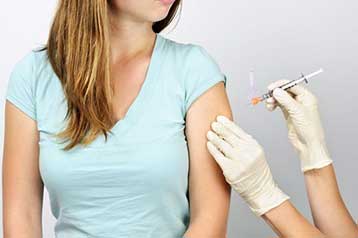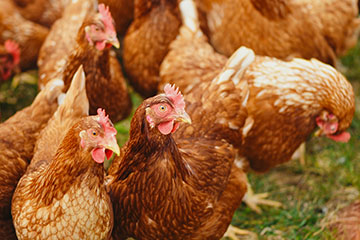Vaccines Preventable Diseases
Allergy to Vaccine Components
Vaccine components can cause allergic reactions among certain recipients. These reactions can be local or systemic and can include anaphylaxis or anaphylactic-like responses (e.g., generalized urticaria or hives, wheezing, swelling of the mouth and throat, dyspnea, hypotension, and shock). Allergic reactions might be caused by the vaccine antigen, residual animal protein, antimicrobial agents, preservatives, stabilizers, or other vaccine components (161).
Children who have had an apparent severe allergic reaction to a vaccine should be evaluated by an allergist to determine the responsible allergen and to make recommendations regarding future vaccination.
Components of each vaccine are listed in the respective package insert. An extensive list of vaccine components and their use, as well as the vaccines that contain each component, has been published(162) and also is available from CDC (http://www.cdc.gov/vaccines).
Egg protein
The most common animal protein allergen is egg protein, which is found in influenza and yellow fever vaccines because they are prepared using embryonated chicken eggs. Ordinarily, persons who are able to eat eggs or egg products safely can receive these vaccines; persons who have had an anaphylactic or anaphylactic-like allergy to eggs or egg proteins generally should not receive these vaccines. Asking persons if they can eat eggs without adverse effects is a reasonable way to determine which persons might be at risk for allergic reactions from yellow fever and influenza vaccines. A regimen for administering influenza vaccine to children with egg hypersensitivity and severe asthma has been developed (163,164)
Measles and mumps vaccine viruses are grown in chick embryo fibroblast tissue culture. However, persons with a severe egg allergy can receive measles- or mumps-containing vaccines without skin testing or desensitization to egg protein (2). Rubella and varicella vaccines are grown in human diploid cell cultures and can safely be administered to persons with a severe allergy to eggs or egg proteins. The rare severe allergic reactions after measles or mumps vaccination or MMR are not thought to be caused by egg antigens but to other components of the vaccine (e.g., gelatin) (165--168). MMR, MMRV, and other vaccines contain hydrolyzed gelatin as a stabilizer. Extreme caution should be used when administering vaccines that contain gelatin to persons who have had an anaphylactic reaction to gelatin or gelatin-containing products.
Antimicrobial agents and other preservatives
Certain vaccines contain trace amounts of antimicrobial agents or other preservatives (e.g., neomycin or thimerosal) to which patients might be allergic, although such allergies are rare. The information provided in vaccine package inserts should be reviewed carefully before deciding whether a patient with such allergies should receive the vaccine. No licensed vaccine contains penicillin or penicillin derivatives.
Neomycin
Persons who have had anaphylactic reactions to neomycin should not receive vaccines containing neomycin. Most often, a neomycin allergy is a contact dermatitis, a manifestation of a delayed-type (cell-mediated) immune response rather than anaphylaxis (169,170). A history of delayed-type reactions to neomycin is not a contraindication for administration of these vaccines.
Thimerosal
Thimerosal, an organic mercurial compound in use since the 1930s, is added to certain immunobiologics as a preservative. Since mid-2001, vaccines routinely recommended for young infants have been manufactured without thimerosal as a preservative. Live, attenuated vaccines have never contained thimerosal. Thimerosal-free formulations of inactivated influenza vaccine are available. Inactivated influenza vaccine also is available in formulations with trace thimerosal, in which thimerosal remains as a manufacturing residual but does not function as a preservative, and in formulations that contain thimerosal as a preservative. Thimerosal at a preservative concentration is present in certain other vaccines that can be administered to children (e.g., Td and DT). Information about the thimerosal content of vaccines is available from FDA
On the basis of limited scientific data, some investigators have asserted that receiving thimerosal-containing vaccines might induce an allergy. Allergies to thimerosal usually have been described as local delayed-type hypersensitivity reactions (171--173). Thimerosal elicits positive delayed-type hypersensitivity patch tests in 1%--18% of persons tested; however, these tests have limited or no clinical relevance (174,175). The majority of persons do not experience reactions to thimerosal administered as a component of vaccines even when patch or intradermal tests for thimerosal indicate hypersensitivity (175). A local or delayed-type hypersensitivity reaction to thimerosal is not a contraindication to receipt of a vaccine that contains thimerosal.
Latex Allergy
Latex is sap from the commercial rubber tree. Latex contains naturally occurring impurities (e.g., plant proteins and peptides) that might be responsible for allergic reactions. Latex is processed to form natural rubber latex and dry, natural rubber. Natural rubber latex and dry, natural rubber might contain the same plant impurities as latex but in lesser amounts. Natural rubber latex is used to produce medical gloves, catheters, and other products. Dry, natural rubber is used in the tip of syringe plungers, the tip on prefilled syringes, vial stoppers, and injection ports on intravascular tubing. Synthetic rubber and synthetic latex also are used in medical gloves, syringe plungers, and vial stoppers. Synthetic rubber and synthetic latex do not contain natural rubber or natural latex and do not contain impurities linked to allergic reactions. Latex or dry, natural rubber used in vaccine packaging generally is noted in the manufacturers' package inserts.
The most common type of latex sensitivity is a contact-type (type 4) allergy, usually as a result of prolonged contact with latex-containing gloves (176). However, latex allergies associated with injection procedures have been described among patients with diabetes mellitus (177--179). Allergic reactions (including anaphylaxis) after vaccinations are rare. A review of reports to VAERS identified only 28 cases of possible immediate-type anaphylactic reactions among more than 160,000 vaccine adverse event reports (180).
If a person reports a severe (anaphylactic) allergy to latex, vaccines supplied in vials or syringes that contain natural rubber latex should not be administered unless the benefit of vaccination clearly outweighs the risk for a potential allergic reaction. In these cases, providers should be prepared to treat patients who are having an allergic reaction. For latex allergies other than anaphylactic allergies (e.g., a history of contact allergy to latex gloves), vaccines supplied in vials or syringes that contain dry, natural rubber or natural rubber latex may be administered.






